Day 5 - Plitsch Platsch Badespass
Today was the last full day without Mama at home. Astrid won't see her Friday but I can't wait to hug her again tomorrow night.
Today was a day full of chores: Plumber, Roofer, Escrow Company etc. That's why we didn't have time to do something special today. Due to Thursday's LA traffic, I came home late (5.10 pm) and we just stayed inside, played with her blocks, read a few books and snuggled a bit.
Another happy day for Astrid.

First picture of the day. That smile is killer.
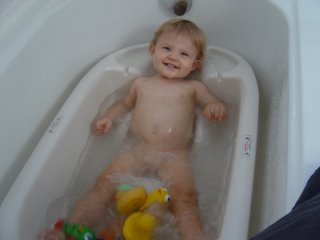
During this week, Astrid, instead of sitting up in the bathtub, started to lay down and relax during her bath. She's growing up.
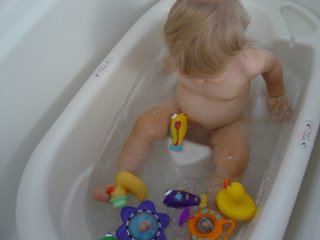
Look at all these toys in her tub. She demands all of them inside the tub.

Playing with her plastic duck.
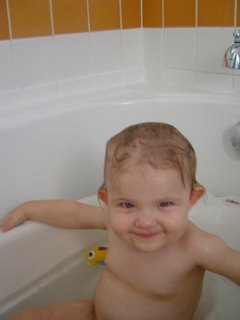
I know it's time to go to bed now. But I'm ready for more mischief tomorrow. And, by the way, when the hell is Mama coming home?
Day 4 without Mama - Climbing Mt. Everest
Astrid had a long nap today: From 9am-12pm, I guess it was caused by her long night with Papa in Hollywood yesterday.
I came home around 4.30, saw her in best spirits and decided to go jogging with her. My guess was, she would love to go to Griffith Park.
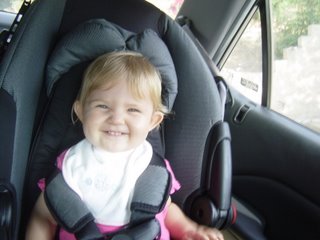
My guess was right. She couldn't wait.
First, I jogged with her for 30 minutes, then one tire of my jogging stroller blew and I had to carry her for 2 miles while carrying the stroller at the same time. Rose, when you come home my biceps will resemble Schwarzenegger's.
Finally, we arrived at a big lawn and adjacent playground, and she could run around at her will.

And she did, didn't she? I think she's going to be a marathon runner. Perfect running position.

Little gift for daddy. What's it going to be?

A beautiful leaf. I tried to teach her 'Blatt'. She hasn't spoken one word German yet. It'll happen.
And then came the big challenge: A little hill for us, a Mt. Everest for Astrid. She must have fallen down 20 times but, in the end, she made it happen. Great job.
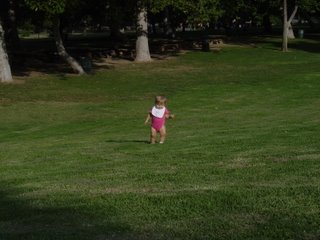
Here's our little mountaineer. Man, was she tired when we came home.
Day 3 without Mama - Astrid claims her star
I had to take care of some business in Hollywood today and took Astrid with me. I promised her a little surprise and wanted to make sure she has a good time being with me in a business environment.
She had a good day with our nanny today and was in good spirits.

Stop it, daddy, I can't wait much longer for the surprise!
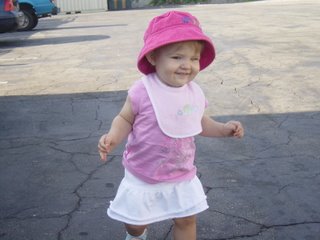
Where are we going? Are you playing games with me?

Here it is. I reserved a star for her on Hollywood Boulevard. (Sorry, didn't have time to clean beforehand...) She loved looking at all the stars but the empty one was her favorite.

I can't wait until they engrave my name in this star.

Her first 'red carpet' walk on Hollywood Boulevard.
We went home late and, right before she went to bed, she told me she misses mama tremendously.
It's Day 2 without Mama and I had something special planned: In yesterday's LA Times was a big article about Glendale Forest Lawn. This cemetery and park is maybe 3 miles away from our house. We can almost touch it, it's so close. I've never been there before and was always curious. However, in Germany cemeteries are very private areas and not a place you want to hang out or visit, unless you have business to take care of.
The article (I pasted it below) mentioned that Glendale Forest Lawn was the biggest tourist attraction in Southern California until Disneyland opened. Good reason to visit it.
Finally, a reprieve from the oppressive heat and we headed out there right after I came home. To say the least, it's a huge property. And Astrid had a blast. She just loved to walk on the grass and sidewalk and explore all the statues and monuments.

Here's she's adoring the statue of David. A replica. (Y0u can see it in the third image - damn Blogspot, screwed up the order again)

This is my favorite picture. Ever. It says so much about being a parent and a kid. She stood there for over a minute and soaked in the mystery of life. Looking at this picture still takes my breath away. She seems so small and fragile but also so much on her way to discover her won mystery of life.

Here's the statue of David she looked at in the first picture. She was amazed by the size and beauty.

Are we in Scotland or in LA? Astrid loved to walk around the lawn of this replice of a church from the 9th century. Unfortunately, it wasn't open. We'll wait to go until Rose comes back.

I love well-manicured lawns.
It was an impressive afternoon at Forest Lawn. It was really a celebration of life. There were so many more things to see but it will have to wait until Rose comes back. It's so much more fun to discover it with the whole family and Rose should never feel left out. But we had a good time, she ran around a lot and it tired her out and we have some beautiful shots.
Rose, next weekend?
From LA Times
Forest Lawn at 100: The Rest Is History
The Glendale cemetery has long been a tourist draw. Amid the burials -- and, yes, weddings -- is a distinctly California kitsch.By Bob PoolTimes Staff WriterJuly 16, 2006She figured they'd made a wrong turn on their way to the wedding."This is a cemetery," Andrea Mills told her husband.That's when Garrett Mills explained that friends Brad Hubisz and Catherine Moore were getting married at Forest Lawn.What better place to pledge love for each other " 'till death do us part," as Hubisz and Moore did during their ceremony at the Glendale memorial park's Wee Kirk o' the Heather before a gathering of friends and family.The tiny stone chapel is modeled after a 14th century Scottish church. It is one of the unusual features that over the last 100 years has helped turn Forest Lawn into a world-famous tourist attraction."At first I thought it was odd to have a wedding in a cemetery," said Garrett Mills, of Pasadena. "I was a little skeptical. But they described how gorgeous the chapel was. And it really is."Down the grassy hill from the chapel, John Llewellyn, sitting on the second floor of the Tudor-style building that is Forest Lawn's combination headquarters, mortuary and flower shop, grinned at that reaction."In my family there doesn't seem anything odd at all about getting married here," Llewellyn laughed. His parents were, he said, and so was he. And his daughter is scheduled to be this fall.Llewellyn, 58, is the great-nephew of Forest Lawn's founder. As its current chief executive officer, he's also in charge of a yearlong celebration marking its centennial.Over the last century, Forest Lawn has been mocked by novelist Evelyn Waugh and blamed as the cause of soaring burial costs. It also became an unlikely magnet for tourists who see the feel-good cemetery as a distinctly California invention.So the 290-acre burial ground that straddles the Glendale-Los Angeles boundary line has plenty to commemorate.It may have been the first cemetery in the United States to ban above-ground, monument-style tombstones and instead require ground-level markers (better views, less cemetery-like).It was the first to incorporate distinctive architectural motifs, creating faux European castles and cathedrals that critics have likened to a Disneyland of death. The designs were meant to entice visitors to linger in a park-like setting.As it marks its 100th birthday, Forest Lawn isn't the tourist draw it was in its heyday — and some of its more flamboyant flourishes, such as talking statues, have been toned down.But as those at the Hubisz-Mills wedding can attest, there's nothing else quite like it.
Hubert Eaton called himself "The Builder" after he became Forest Lawn's general manager in 1917. Created in 1906, the cemetery was a dusty patch dotted with dried scrub and scattered headstones and obelisks.Eaton had sold burial plots there for several years and viewed the place as dismal and uninviting. So he developed a plan to transform the cemetery, a vision he called "The Builder's Creed," which would eventually be chiseled in stone outside a grand art-filled structure called the "Great Mausoleum."The "cemeteries of today are wrong because they depict an end, not a beginning. They have consequently become unsightly stone yards," Eaton wrote. "I shall try to build at Forest Lawn a great park, devoid of misshapen monuments and other customary signs of earthly death, but filled with towering trees, sweeping lawns, splashing fountains, singing birds, beautiful statuary, cheerful flowers…."Eaton scoured Europe for artworks he could either purchase or replicate for his new memorial park.Deeply religious, he commissioned an Italian-made stained-glass replica of Leonardo da Vinci's "The Last Supper." It was installed in a mausoleum equipped with mechanical shutters that dimmed and brightened the imagery on command.Eaton turned to Britain for inspiration for nonsectarian funeral chapels he could build on the Glendale grounds.The first, a replica of a 600-year-old church in Stoke Poges, England, was erected in 1921. But even Eaton was stunned when a Los Angeles couple, Cora Gregory Wells and Archie Milton Howes, asked two years later to be married in the Little Church of the Flowers.The Wee Kirk o' the Heather was built in 1929 as a copy of Annie Laurie's church at Glencairn in Scotland. A decade later, Eaton built the Church of the Recessional, a reproduction of the Parish Church of St. Margaret in Rottingdean, England.To house his rapidly growing collection of original and reproduction sculpture, Eaton built an art gallery.The "Holly Terrace" was filled with the works of prominent American sculptors and bronzes of such figures as George Washington, Mark Twain, Abraham Lincoln and Teddy Roosevelt.He added a museum to display more of Forest Lawn's increasingly eclectic art collection: the "world's largest black opal," a brooding Easter Island stone head, bronze Remington cowboys and replicas of virtually every statue ever done by Michelangelo.Eaton built the 1,000-seat Hall of the Crucifixion — with room for at least twice that many — to display "the world's largest religious painting.""It's all so beautiful," marveled visitor Pasquele Bruno as he stepped from the auditorium with two of wife Maria Bruno's cousins in tow. The relatives were visiting from Venice, Italy, and they remarked in Italian at how clean and orderly Forest Lawn is."I've been coming here regularly for 43 years," said Bruno, a Glendale furniture manufacturer. He translated for his visitors: "They are saying, 'There's nothing like this in Italy.' I bring every guest we have here. I want to show them how beautiful this is."Maria Bruno nodded enthusiastically. "I never get tired of it. We're going over to see 'The Last Supper' next," she said.At the mausoleum where the stained-glass window is on display, a Forest Lawn employee reminded them that cellphones had to be turned off before the lights dimmed, the curtain opened and recorded narration began explaining the window's history. Only one other person was in the room for the 4 p.m. showing.
It wasn't always this way.In its heyday in the 1950s, Forest Lawn was a genuine tourist attraction.It was Southern California's top visitor draw until 1957, when the recently opened Disneyland surpassed it."They were true pioneers," said John Resick, president of the Cemetery and Mortuary Assn. of California. "You look around the United States and you see their influence."But though Forest Lawn spawned many imitators in the funeral business, it also sparked much criticism.Waugh, the British novelist, wrote the biting 1948 satire "The Loved One," drawing on Forest Lawn's ambience and Eaton's marketing strategy of selling "pre-need" burial plots for his own plot line.Muckraking author Jessica Mitford blamed Eaton for probably having "more influence on trends in the modern cemetery industry than any other human being."Eaton stirred controversy in 1964 when he allegedly made segregationist remarks during a speech at the Forest Lawn Foundation's annual college writing awards dinner.Two years later, there was a flap over Eaton's penchant for placing signs in the cemetery that criticized "big government," communism, Supreme Court decisions and taxes. He died in 1966 at age 85.These days, Forest Lawn seems to have mellowed. Eaton's fanciful names for areas of the cemetery — such as Slumberland, Lullaby Land and Vesperland — have so frequently been copied by other cemeteries that they no longer raise eyebrows.And, compared with Eaton's extravagance, the 100th anniversary celebration seems downright restrained."At one time there was music piped to some parts of the park, and at key statues there were lectures about the artwork," said Llewellyn, who joined the family business in 1972. "But it was hard to maintain as the equipment got older."Forest Lawn is low-key about some things. For privacy reasons, employees decline to identify the locations of celebrities' graves. Officials won't reveal the number of people who are buried at the park (one estimate is about 350,000) because they want funerals to feel personal and not mass-produced.Officials are more forthcoming about Forest Lawn weddings, however. They say an estimated 70,000 couples have been married there since Wells and Howes started it all in 1923.Weddings are conducted late in the day, when no funerals are scheduled.The music of Beethoven and Handel filled the Wee Kirk o' the Heather chapel for the Moore-Hubisz nuptials.The Glendale couple chose the location because it reminded them of the East Coast and of Scotland, where Moore studied."We talked about the location beforehand," said the couple's pastor, the Rev. Randy Lovejoy of Silver Lake Community Church."This is my first wedding here. I prefer it to a funeral."
Sunday without Mama
Mama is out of town (business trip) and Astrid is stuck with Papa for almost a week. That's the first Sunday Rose didn't spend with Astrid and I'm sure it was pretty hard on her.
Pictures below are a dairy of our day but, I gotta say, Blogspot is a real mess. I should be able to add pics in my order but, for some reason, Blogspot changes the order arbitrarily...Anyway, not a big deal, just a bit annoying.

We picked up Jill and Bill to drive them to LAX for their trip to Europe. Astrid walked from the car to the entrance door but, after that, she just started to cry and only I could calm her down. I felt bad for Jill but she had her bonding time with Astrid in the backseat when I drove to the airport.
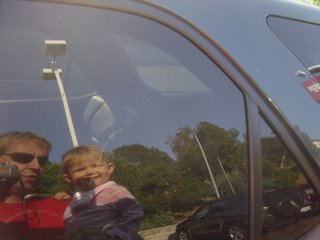
Getting my latte at Starbucks. Astrid enjoyed her reflection in the glass.

Enjoying her breakfast

This is actually the first picture of our Mama-less Sunday. She woke up at 7 am and was ready to take on the day. She asked for Mama a few times and I was hoping to suffice for this week.
Sunday without Mama - Pt.2
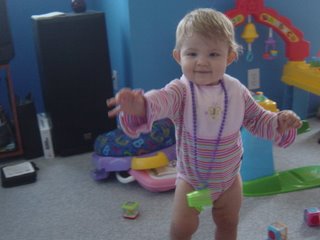
Enjoying her beads and little cup for future drinks

Going with daddy to Starbucks

Playing with her little doggie

I'm ready for more fun
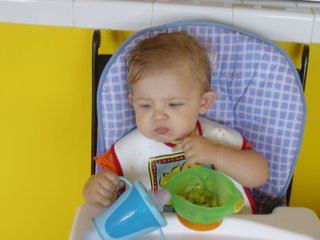
Once in a while I need a break...and some broccoli
You know you're a happy parent and husband
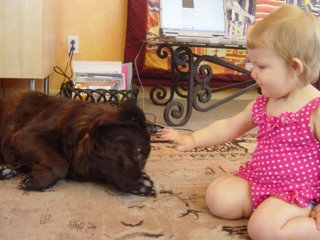
When your wife is fast asleep in the living room and baby in her crib, you go downstairs to fetch a drink, find the filled diaper bag all over the floor because your dog had to rummage through it, trying to find treasures, and you just get your paper towels and disinfectant, clean the floor and smile.
Oh, it's so beautiful to be a father...
Happy Father's Day
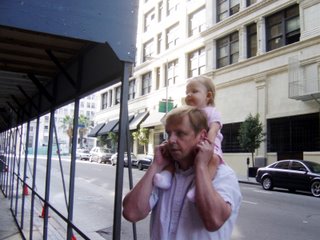
I found this article in the Time. I don't agree with everything the author says but I'm a big fan of the last paragraph.
Does Fatherhood Make You Happy?By DANIEL GILBERT
Sonora Smart Dodd was listening to a sermon on self-sacrifice when she decided that her father, a widower who had raised six children, deserved his very own national holiday. Almost a century later, people all over the world spend the third Sunday in June honoring their fathers with ritual offerings of aftershave and neckties, which leads millions of fathers to have precisely the same thought at precisely the same moment: "My children," they think in unison, "make me happy."
Could all those dads be wrong?
Studies reveal that most married couples start out happy and then become progressively less satisfied over the course of their lives, becoming especially disconsolate when their children are in diapers and in adolescence, and returning to their initial levels of happiness only after their children have had the decency to grow up and go away. When the popular press invented a malady called "empty-nest syndrome," it failed to mention that its primary symptom is a marked increase in smiling.
Psychologists have measured how people feel as they go about their daily activities, and have found that people are less happy when they are interacting with their children than when they are eating, exercising, shopping or watching television. Indeed, an act of parenting makes most people about as happy as an act of housework. Economists have modeled the impact of many variables on people's overall happiness and have consistently found that children have only a small impact. A small negative impact.
Those findings are hard to swallow because they fly in the face of our most compelling intuitions. We love our children! We talk about them to anyone who will listen, show their photographs to anyone who will look and hide our refrigerators behind vast collages of their drawings, notes, pictures and report cards. We feel confident that we are happy with our kids, about our kids, for our kids and because of our kids--so why is our personal experience at odds with the scientific data?
Three reasons.
First, when something makes us happy we are willing to pay a lot for it, which is why the worst Belgian chocolate is more expensive than the best Belgian tofu. But that process can work in reverse: when we pay a lot for something, we assume it makes us happy, which is why we swear to the wonders of bottled water and Armani socks. The compulsion to care for our children was long ago written into our DNA, so we toil and sweat, lose sleep and hair, play nurse, housekeeper, chauffeur and cook, and we do all that because nature just won't have it any other way. Given the high price we pay, it isn't surprising that we rationalize those costs and conclude that our children must be repaying us with happiness.
Second, if the Red Sox and the Yankees were scoreless until Manny Ramirez hit a grand slam in the bottom of the ninth, you can be sure that Boston fans would remember it as the best game of the season. Memories are dominated by their most powerful--and not their most typical--instances. Just as a glorious game-winning homer can erase our memory of 812 dull innings, the sublime moment when our 3-year-old looks up from the mess she is making with her mashed potatoes and says, "I wub you, Daddy," can erase eight hours of no, not yet, not now and stop asking. Children may not make us happy very often, but when they do, that happiness is both transcendent and amnesic.
Third, although most of us think of heroin as a source of human misery, shooting heroin doesn't actually make people feel miserable. It makes them feel really, really good--so good, in fact, that it crowds out every other source of pleasure. Family, friends, work, play, food, sex--none can compete with the narcotic experience; hence all fall by the wayside. The analogy to children is all too clear. Even if their company were an unremitting pleasure, the fact that they require so much company means that other sources of pleasure will all but disappear. Movies, theater, parties, travel--those are just a few of the English nouns that parents of young children quickly forget how to pronounce. We believe our children are our greatest joy, and we're absolutely right. When you have one joy, it's bound to be the greatest.
Our children give us many things, but an increase in our average daily happiness is probably not among them. Rather than deny that fact, we should celebrate it. Our ability to love beyond all measure those who try our patience and weary our bones is at once our most noble and most human quality. The fact that children don't always make us happy--and that we're happy to have them nonetheless--is the fact for which Sonora Smart Dodd was so grateful. She thought we would all do well to remember it, every third Sunday in June.
Harvard psychologist Daniel Gilbert is the author of Stumbling on Happiness. To read an interview, go to
time.com/gilbert
Plitsch-Platsch Badespass
Rose had a fabulous idea: Why not buy a small swimming pool for Astrid to sit in splash around while her parents are watching her and having the occasional drink? She had me at drink. Right before we left, i purchased this little pool at Target for 9.95 and it's worth all the money.

The water is a little bit cold but she got used to it immediately

Pointing at the beautiful roses

And there's Bertha. Additional benefit of our pool: She gets tired very quickly....:)
Bertha has a new friend
I decided to have a dog when I went through a real hard time in my life. I met her in a pound in Burbank and fell immediately in love with her. Don't ask me why, I just did. She was afraid of me, she wanted to get away from me and she had an allergy problem. So what? I still took her home and never regretted it.
Most of the day, she lives on our balcony and Astrid just sees her through our glass doors. But today I let Astrid play with her. And Astrid had a grand time.

Trying the Astrid choke.

Giving Bertha a massage.

Pulling on Bertha's ear. Bertha is such a sheep, you can do anything to her and she would never snap. But she has a second side: She's part Chow and she can be an aggressive fighter when it comes to protecting us and standing up against other dogs.
Right now, Bertha is tolerating Astrid but very soon she'll love to play with her. When we are out town, Jeff takes care of Bertha and they love playing with her. You should see her when she comes home after a week of playing with the kids: she sleeps for hours. Exhausted.




































